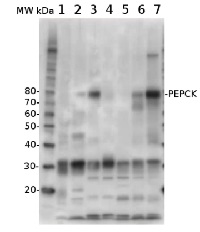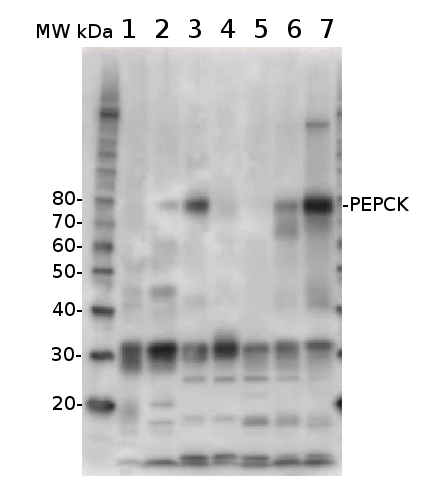1

Anti-PEPCK | PEP carboxykinase
AS07 241 | Clonality: Polyclonal | Host: Rabbit | Reactivity: [global antibody] for plants Ananas comosus, Miscantus giganteus, Mouse, Nannochloropsis oceanica, Oryza sativa, Panicum maximum,, Panicum virgatum, Phaseolus vulgaris, Saccharum spp. hybrid clone C91-301, Spartina alterniflora, Spartina patens, Zea mays
Benefits of using this antibody
- Product Info
-
Immunogen: KLH-conjugated synthetic peptide well conserved in both PEPCK1 and 2 sequences from different plant species including Zea mays Q9SLZ0
Host: Rabbit Clonality: Polyclonal Purity: Serum Format: Lyophilized Quantity: 200 µl Reconstitution: For reconstitution add 200 µl of sterile water Storage: Store lyophilized/reconstituted at -20°C; once reconstituted make aliquots to avoid repeated freeze-thaw cycles. Please remember to spin the tubes briefly prior to opening them to avoid any losses that might occur from material adhering to the cap or sides of the tube. Tested applications: Western blot (WB) Recommended dilution: 1 : 1000 (WB) Expected | apparent MW: 73 | 78 kDa
- Reactivity
-
Confirmed reactivity: Ananas comosus, Miscantus giganteus, Mouse, Nannochloropsis oceanica, Oryza sativa, Panicum maximum,, Panicum virgatum, Phaseolus vulgaris, Saccharum spp. hybrid clone C91-301,Setaria viridis, Spartina alterniflora, Spartina patens, Zea mays Predicted reactivity: Brassica napus, Chromera velia, Cucumis sativus, Flaveria sp., Lycopersicon esculentum, Medicago sativa, Oryza sativa, Urochloa panicoides, Zoysia japonica, Zea mays
Species of your interest not listed? Contact usNot reactive in: Arabidopsis thaliana, Pinus yunnanensis - Application Examples
-
Application example

20 µg of total protein from (1) Arabidopsis thaliana total cell extracted with Protein Extration Buffer, PEB (AS08 300), (2) Phaseolus vulgaris total cell, extracted with PEB, (3) Zea mays total cell extracted with PEB, (4) Miscanthus giganteus total cell extracted with PEB, (5) Panicum virgatum total cell extracted with PEB, (6) Spartina alterniflora total cell extracted with PEB, (7) Spartina patens total cell extracted with PEB, were separated on 4-12% NuPage (Invitrogen) LDS-PAGE and blotted 1h to PVDF. Blots were blocked immediately following transfer in 2% blocking reagent in 20 mM Tris, 137 mM sodium chloride pH 7.6 with 0.1% (v/v) Tween-20 (TBS-T) for 1h at room temperature with agitation. Blots were incubated in the primary antibody at a dilution of 1: 10 000 for 1h at room temperature with agitation. The antibody solution was decanted and the blot was rinsed briefly twice, then washed once for 15 min and 3 times for 5 min in TBS-T at room temperature with agitation. Blots were incubated in secondary antibody (anti-rabbit IgG horse radish peroxidase conjugated) diluted to 1:50 000 in 2% blocking solution for 1h at room temperature with agitation. The blots were washed as above and developed for 5 min with chemiluminescence detection reagent according the manufacturers instructions. Images of the blots were obtained using a CCD imager (FluorSMax, Bio-Rad) and Quantity One software (Bio-Rad).
- Additional Information
-
Additional information (application): Due to the MW of this protein we suggest to use a gradient gel for protein separation and a longer transfer time. Higher protein load 10-20 µg is adviced when working with this antibody.
Antibody can be also used following 2D gel electrophoresis.
This product can be sold containing ProClin if requested. - Background
-
Background: Phosphoenolpyruvate carboxykinase (PEPCK, PEP carboxykinase) is an enzyme that catalyses the conversion of oxaloacetate and ATP to phosphoenelpyruvate, carbon dioxide and ADP. PEPCK is encoded by two genes in plants: pck1 and pck2. - Product Citations
-
Selected references: Wei et al. (2019). Transcriptomic and proteomic responses to very low CO 2 suggest multiple carbon concentrating mechanisms in Nannochloropsis oceanica. Biotechnol Biofuels 12: 168.
Shen et al. (2016). The existence of C4-bundle-sheath-like photosynthesis in the mid-vein of C3 rice. Rice (N Y). 2016 Dec;9(1):20. doi: 10.1186/s12284-016-0094-5. Epub 2016 May 10.
Aragón et al. (2013). The physiology of ex vitro pineapple (Ananas comosus L. Merr. var MD-2) as CAM or C3 is regulated by the environmental conditions: proteomic and transcriptomic profiles. Plant Cell Rep. Aug 20. (Ananas comosus, western blot detection following 2D gel electrophoresis) - Protocols
-
Agrisera Western Blot protocol and video tutorials
Protocols to work with plant and algal protein extracts - Reviews:
-
This product doesn't have any reviews.
Accessories

AS07 242 | Clonality: Polyclonal | Host: Rabbit | Reactivity: A. thaliana, G. max, N. tabacum, O. sativa, Populus sp., S. lycopersicum, S. elongatus, S. oleracea , Z. mays
Benefits of using this antibody


